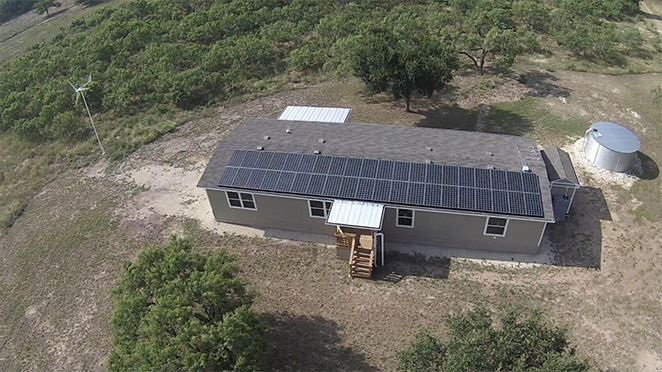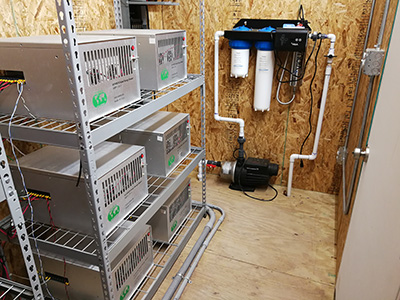New System Shows Homeowners How Utilities Are Used – And How to Cut Back
By: Kaitlyn Hale

It's easy to forget that water is a finite resource when all it takes for a seemingly endless supply is a turn of the faucet.
Texas Tech researchers are aiming to give consumers a way to make informed decisions about the ways they use utilities like water and electricity, along with a way to reduce a household's reliance on the grid.
The patent pending Home Utility Management System, or HUMS, pairs a water catchment system, solar panels, and a wind turbine with a monitoring system that lets residents see exactly how much water and electricity they use and provides suggestions on ways to improve consumption. Texas Tech University currently has a pending patent application filed in March 2019 with inventors Brian Ancell, Carol Lindquist, Nadia Flores-Yeffal, Beibei Ren, and Ken Rainwater.
"It basically gives residents a way to have an informed choice about their usage. We don't have that right now," said Carol Lindquist, assistant professor of practice of sociology in the Department of Sociology, Anthropology, and Social Work.
"You basically get your bill once a month," she said. "You don't know what you're doing with that stuff. You don't know how it's being used, and this gives you that information. It's that old thing where if you educate people, if you're given that information, then you can use it to make intelligent choices."
The HUMS calculates the amount of water and electricity a home has stored, then compares it to the household's usage rates and the weather forecast. If it isn't supposed to rain in the next 10 days, but the water in the catchment tank will only last five days, the system can suggest ways for the homeowner to cut back on usage, Lindquist said, because it tracks how much water or power is used by every appliance in the house, from the dishwasher to the lightbulbs.
For example, a household that showers and runs the dishwasher every day could choose to shower every other day or run the dishwasher every three days. If the homeowner decides not to make those changes, they can also choose to dump five days of water from the grid into the home's storage tank.
"The whole basis of the system is to create a sustainable water and power infrastructure for society," said Brian Ancell, an associate professor of atmospheric science in the Department of Geosciences. "So, we're doing this at the residential level. Right now, water and power supplies are all from a central location, and that presents several issues."
Ancell said that current water and power grids are vulnerable to cyber or physical
attack, and a natural disaster can shut parts of a grid down for long periods of time.
A system like the HUMS can alleviate some of that risk for the homeowner, who would
have a steady supply of HUMS-harvested water or electricity available immediately.
In the end, Ancell said, the goal is to fix big problems for society by making these
systems sustainable and affordable.

Ancell is also looking at ways to improve the weather forecasting aspect of HUMS, which is a key part of how the system determines suggestions.
"On my side, weather forecasts aren't perfect," Ancell said. "A lot of the decisions are based on what's coming in, but what's coming in is not certain. So that's the whole weather forecasting part. Incorporating uncertainty is a big deal."
The first HUMS house was set up at the Texas Tech University Center at Junction with a seed grant from the Office of Research & Innovation in November 2018. The space includes a small shed that houses the monitoring equipment, a 10,000 gallon water catchment tank, solar panels, and a small wind turbine. When it rains, water travels through a series of gutters and into the tank.
The project has shifted focus slightly to the water aspect of conservation. While the clean energy aspect is important, solar technology can still be expensive and sometimes inefficient. Though that technology is expected to improve in the coming years, the water system is affordable and can be installed easily and quickly now.
If a homeowner has room for the catchment tank, which is around 12 feet wide and 7 feet tall, then the only other equipment needed consists largely of a desktop computer to run the software and PVC pipe to get the water to the tank. Ancell and Lindquist said that they're also looking to other parts of the world to find ways to better integrate the tank into a property. In coastal communities for example, many houses are built high off the ground to prevent flooding. A water tank could be stored under the house in those circumstances.
"All we have to do is tap into reservoirs of knowledge, so to speak," Lindquist said.
The HUMS project is unique from other smart home technology because it relies on the owner to use the advice given. The current team, comprised of Ancell, Lindquist, civil engineer Ken Rainwater, sociologist Nadia Flores-Yeffal, and electrical engineer Sandeep Nimmagadda, is looking just as closely at the human behavior as the physical functions of the system.
To better understand how the system influences a person's choices, the project is planning two to four testing periods where a couple will spend six months living in the household. Lindquist said she's hoping to answer questions about how individuals interact with the system. Do they follow the instructions? Do they make different choices on what to use or conserve? Do those choices cause conflict?
Lindquist said that conserving behaviors like recycling generally need an emotional commitment for people to stick with them.
"It's not something you do because you have to," Lindquist said. "These behaviors are optional, so where's the emotional commitment in there, and how important is it? That's something that you can measure, but it takes some digging and sensitivity to find it."
Discoveries
-
Address
Texas Tech University, 2500 Broadway, Box 41075 Lubbock, TX 79409 -
Phone
806.742.3905 -
Email
vpr.communications@ttu.edu
